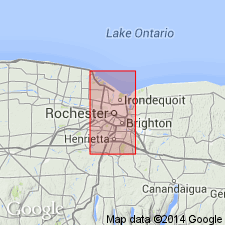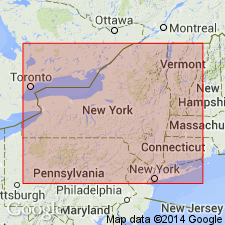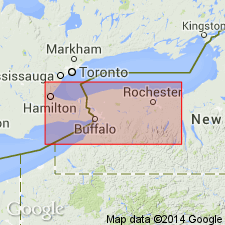
- Usage in publication:
-
- Irondequoit limestone member
- Modifications:
-
- Named
- Dominant lithology:
-
- Limestone
- Shale
- AAPG geologic province:
-
- Appalachian basin
Summary:
Named Irondequoit limestone member of the Clinton formation for town just north of Rochester, NY. Consists of layers of limestone separated by bands of shale. The shale bands in the lower part are green and in upper part are gray. It is considered the top member of the Clinton formation in Rochester and Ontario Beach quads. Overlies Williamson shale and underlies Rochester shale. The Irondequoit is of Silurian age.
Source: GNU records (USGS DDS-6; Reston GNULEX).

- Usage in publication:
-
- Irondequoit Limestone
- Modifications:
-
- Revised
- AAPG geologic province:
-
- Appalachian basin
Summary:
Newly named Salmon Creek Bed occurs at the base of the Irondequoit Limestone in western NY and at the base of the Dawes Formation in east-central NY. Bed consists of 7 to 15 cm pyritic, bioturbated, very fine grained dolostone with small pebbles of quartz and phosphate. Age of the Salmon Creek is shown as Silurian (late Llandoverian-early Wenlockian).
Source: GNU records (USGS DDS-6; Reston GNULEX).

- Usage in publication:
-
- Irondequoit Limestone*
- Modifications:
-
- Revised
- AAPG geologic province:
-
- Appalachian basin
Summary:
Revised the Irondequoit Limestone of the Clinton Group by removing the Rockway Dolomite Member (herein raised to formation rank) and its Salmon Creek Phosphate Bed. The Irondequoit consists of thick-bedded to massive, medium greenish-gray to pinkish-gray, buff-weathering, dolomitic, crinoidal- and brachiopod-rich packstone to grainstone. The lower 1 to 2 ft are typically altered to aphanitic dolomite. Upper beds consist of medium-bedded to massive crinoidal limestone. Thin tongues of green shale with small micritic intraclasts are common. Upper beds include small bioherms that are sparsely fossiliferous, pale greenish-gray, non-bedded micrite masses. Brachiopods and rugose corals are common. Thickness is 11.5 to 22.4 feet. Well exposed on Irondequoit Creek in Webster, NY, and in the Genesee River Gorge in Rochester, NY. Unconformably overlies the Rockway Dolomite and conformably underlies the Rochester Shale in western NY, but unconformably underlies the Rochester in Ontario, CAN. Unit extends eastward from Rochester, NY, to the Clinton type area where it laterally grades into the Kirkland Limestone. Extends westward to the Bruce Peninsula region of CAN and grades into the lower part of the Colpoy Bay Member of the Amabel Formation. The Irondequoit is of Early Silurian (earliest Wenlockian) age based on conodonts and ostracodes. [Report uses Early and Late Silurian time scale of Harland and others (1982).]
Source: GNU records (USGS DDS-6; Reston GNULEX).
For more information, please contact Nancy Stamm, Geologic Names Committee Secretary.
Asterisk (*) indicates published by U.S. Geological Survey authors.
"No current usage" (†) implies that a name has been abandoned or has fallen into disuse. Former usage and, if known, replacement name given in parentheses ( ).
Slash (/) indicates name conflicts with nomenclatural guidelines (CSN, 1933; ACSN, 1961, 1970; NACSN, 1983, 2005, 2021). May be explained within brackets ([ ]).

